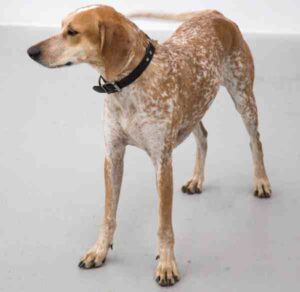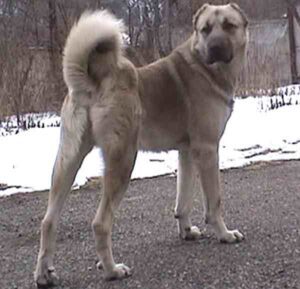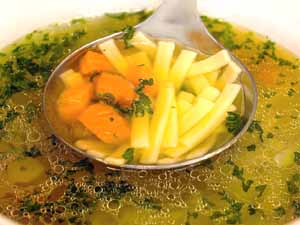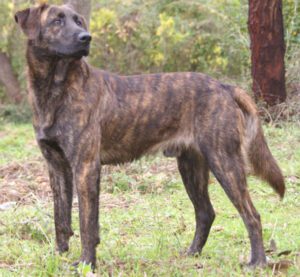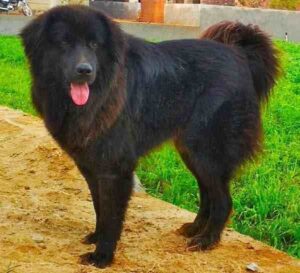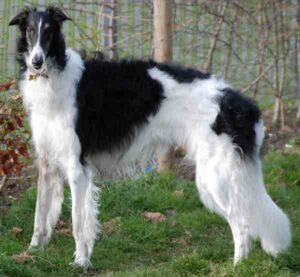The Cane Corso dog is a breed of mastiff from Italy. It is a large breed and used for personal protection, tracking, law enforcement and as a guard dog. It is also known as Cane Corso Italiano.
According to the breed standard of the Fédération Cynologique Internationale, the Cane Corso descends from the molossoid dogs of Ancient Rome; it was once distributed throughout much of the Italian peninsula, but in the recent past was found only in Puglia, in southern Italy.
These dogs became rare after the collapse of the mezzadria system of share-cropping in the 1960s. The modern breed derives from selective breeding from about 1980 of a few surviving animals. A breed society, the Società Amatori Cane Corso, was formed in 1983.
The breed was recognized by the Ente Nazionale della Cinofilia Italiana in 1994, it was provisionally accepted by the Fédération Cynologique Internationale in 1996, and received full acceptance in 2007. It was recognized by the American Kennel Club of the United States in 2010.[1]
Cane Corso Dog Characteristics
The Cane Corso dog is a large and very beautiful breed of mastiff. It is of molossoid type, and is closely related to the Neapolitan Mastiff. In name and form the Cane Corso predates its cousin the Neapolitan Mastiff.
The Cane Corso dogs are well muscled, and less bulky than most other Mastiff breeds. The breed is known as a true and quite possibly the last of the coursing Mastiffs.
The head of these dogs is arguably it’s most important feature. It is large and imposing. The forehead should be flat and convergent to the muzzle. The muzzle is flat, rectangular (when viewed from above), and generally as wide as it is long.
The eyes of these dogs are almond in shape, set straight and when viewed from the front, set slightly above the line of the muzzle. Darker eyes are preferred, however, the color of the eyes tends to emulate the shade of brindling in the coat.
Cane Corso appear in two basic coat colors: black and fawn. This is further modified by genetic pigment dilution to create “blue” (grey, from black) and fromentino (from fawn, where the mask is blue/grey) colors. Brindling of varying intensity is common on both basic coat colors as well, creating Tigrato (black brindle), and Grigio Tigrato (blue brindle). White markings are common on the chest, tips of toes, the chin, and the bridge of the nose.
The Cane Corso dogs are large in size. Average body height of the mature dog is between 24 and 28 inches at the withers for males, and between 23 and 26 inches for the females. Average body weight of the mature dog is between 45 and 50 kg for males, and between 40 and 45 kg for the females.

Temperament
The Cane Corso dogs are docile and affectionate to their owners. They are loving with children and family, and are easily trained. They are an unequalled protector of the owners and their property.
Lifespan
Average lifespan of the Cane Corso dog is between 10 and 12 years.
Feeding
How much a mature dog eats depends on it’s size, age, build, metabolism and activity level. Dogs are individuals, just like people, and they don’t all need the same amount of food.
The Cane Corso dogs are large in size and are highly active. So, their diet should be formulated for a large-sized breed with high exercise needs. Generally 4 to 5 cups of high-quality dry food daily will be enough for a mature dog. You can consult with a vet in your area for better feeding recommendations.
Caring
Taking good care of the animals is very important for raising Cane Corso dogs. Like every other dogs, the Cane Corso also needs early socialization. Exposure to many different people, sights, sounds and experiences are important.
The Cane Corso is a working dog breed that needs plenty of physical activity to stay in shape. So, plan on taking your dog for a brisk walk or job of at least a mile, morning and evening, everyday. If you like to bicycle, get an attachment that will allow the dog to run alongside you.
Provide these dogs with a job for mental stimulation. Good employment for a Cane Corso includes herding livestock, learning tricks, practicing obedience skills or being involved in a dog sport.
Health
The Cane Corso dogs are generally healthy. But like all other dog breeds, they are also prone to certain health conditions.
Their common health problems include hip dysplasia, eyelid abnormalities (such as entropion, ectropion, and cherry eye), demodectic mange and bloat. Always try to keep good contact with a vet in your area.
| Breed Name | Cane Corso Dog |
| Other Names | Also known as Cane Corso Italiano |
| Breed Size | Large |
| Height | Between 24 and 28 inches at the withers for males, and between 23 and 26 inches for the females |
| Weight | Between 45 and 50 kg for males, and between 40 and 45 kg for the females |
| Good as pets | Yes |
| Climate Tolerance | All climates |
| Color | Black and fawn |
| Lifespan | Between 10 and 12 years |
| Good for children | Yes |
| Rarity | Common |
| Country of Origin | Italy |

